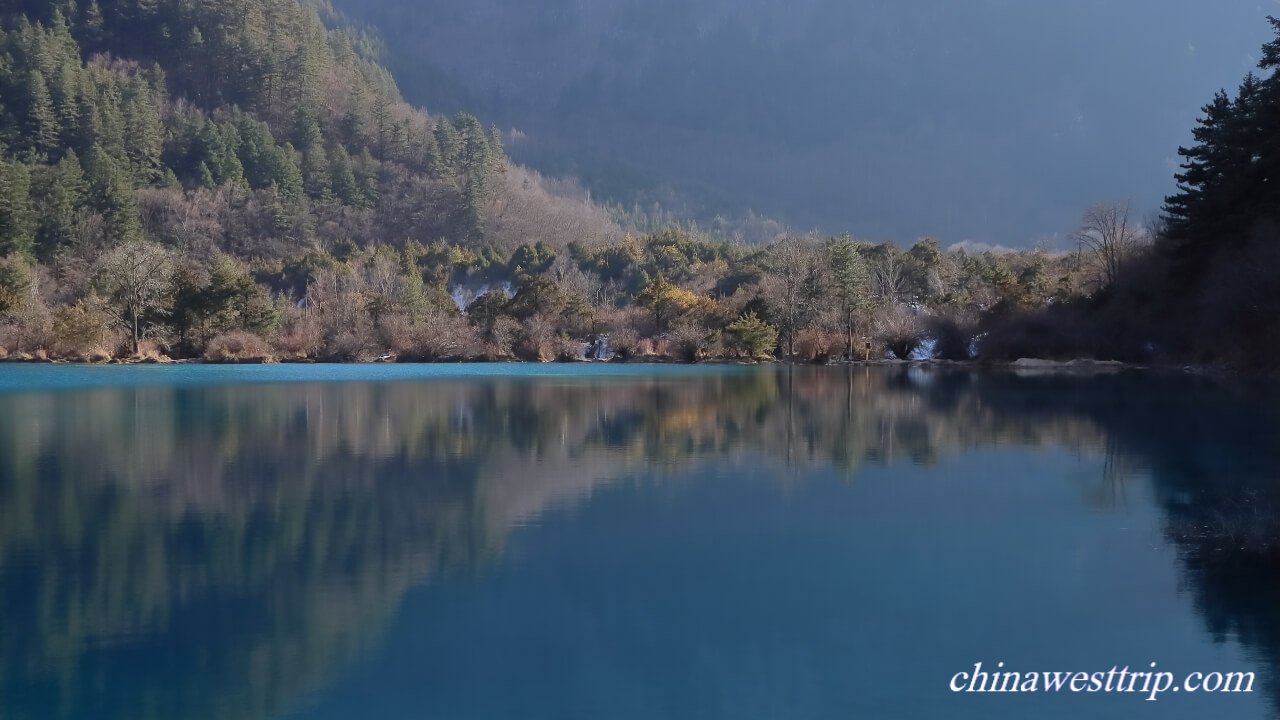
the Flaming Lake Jiuzhaigou
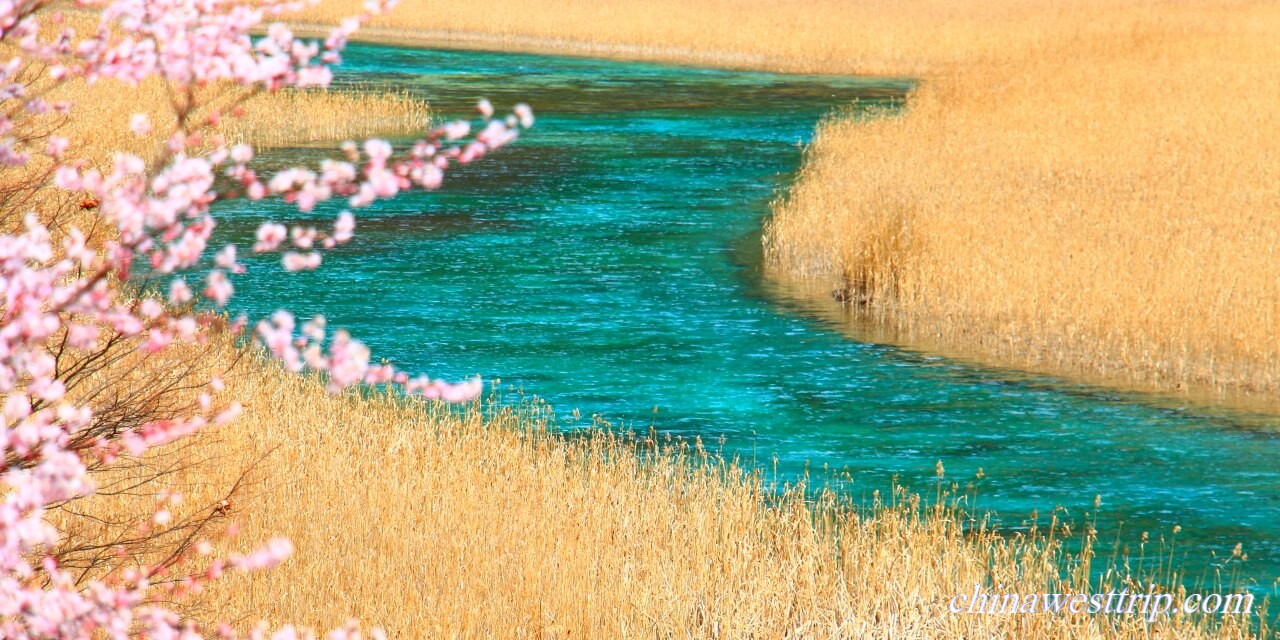
Name in Chinese: 九寨沟 Jiǔ Zhài Gōu [dʒəu dzai gəu]
Duration of Tour: One or Two Days
Location: Aba Tibetan and Qiang Minorities Autonomous Prefecture, Sichuan Province
Highlights: Colorful Lakes, Virgin Forest, Rushing Waterfalls and Tibetan Culture
Must-see Sightseeing Spots: the Five-flower Lake, the Pear-shoal Waterfall, the Long Lake, the Multicolored Pool, Shuzheng Water Fall, Shuzheng Lakes and Shuzheng Village.
Reputations: A World Natural Heritage Site, A National Five-star Scenic Area, A World Bio-sphere Reserve, A Key National Natural Reserve, A National Geo-park
Jiuzhai Valley National Park is well-known as the Fairyland on the Earth. It has six wonders, including multicolored lakes, rushing waterfalls, virgin forest, sunrise, blue ice and authentic Tibetan culture. A popular saying goes that no more water in other places will interest you after you visit Jiuzhai Valley. Water is considered as the soul of its natural beauty. The water is so clear that you could see the bottom of the streams and lakes even at 30 meters(98 feet) in depth. The lakes are colorful due to the reflection and the sediment of calcium carbonate. Owning to the mirror-like lakes, Jiuzhai Valley looks like a wonderland where shoals of fish are swimming in the sky, and birds are flying in the water. It is better to see once than hear a hundred times.
Jiuzhai means nine Tibetan villages. There were nine Tibetan villages in the valley. The valley remained unknown for thousands of years until some lumberjacks accidentally discovered it in 1970s. It belongs to a carbonate barrier lake landform which was formed due to the geographic movement in glaciations, earthquakes and calcification. There is a legend about Jiuzhai Valley. It goes that a male deity and a female deity fell in love with each other a long time ago. The male deity is called Dage, and the female Wonuo Semo. One day, they came to the valley and were completely enchanted with the picturesque landscape of the fairyland Jiuzhai Valley. Both of them deeply loved the birds, animals, forests and mountains in the valley. Then, they decided to reside in Jiuzhai Valley. Unexpectedly, a devil called Shemozha did not want the male deity to stay in the valley. The devil tried to drive the male deity out by force, so that he could marry the female deity. They fought a fierce battle against each other. During their battle, the female deity was snatched away by the devil. She was so scared that she dropped her mirror in panic. The mirror was given to her by her lover. It was broken into over a hundred pieces, which suddenly turned into beautiful lakes. The devil was finally defeated by the male deity. Thereafter, Dage and Wonuo Semo live together and safeguard Jiuzhai Valley.
The whole national park covers an area of 64,297 hectares(158,881 acres), consisting of 114 lakes, 17 splashing waterfalls, 47 springs, 12 turbulent streams, 3 valleys and 3 Tibetan villages. The three valleys are in the shape of the letter “Y”, including Shuzheng Valley, Rize Valley and Zezhawa Valley. The must-go sightseeing spots include the Five-flower Lake, the Pearl Waterfall, the Long Lake, the Multicolored Pool, Shuzheng Water Fall, Shuzheng Lakes and Shuzheng Village.
The Five-flower Lake
The lake is 2,472 meters(8,110 feet) above sea level. It is an ideal place for photography. The algae and bryophyte thrive under the water. The ribbons of calcium sediments separate those water plants into multicolored clusters. When surrounding maples and smoke trees turn red in autumn, the reflection looks like raging flames, setting off the clusters of plants and the sediments ribbons in multi-colors.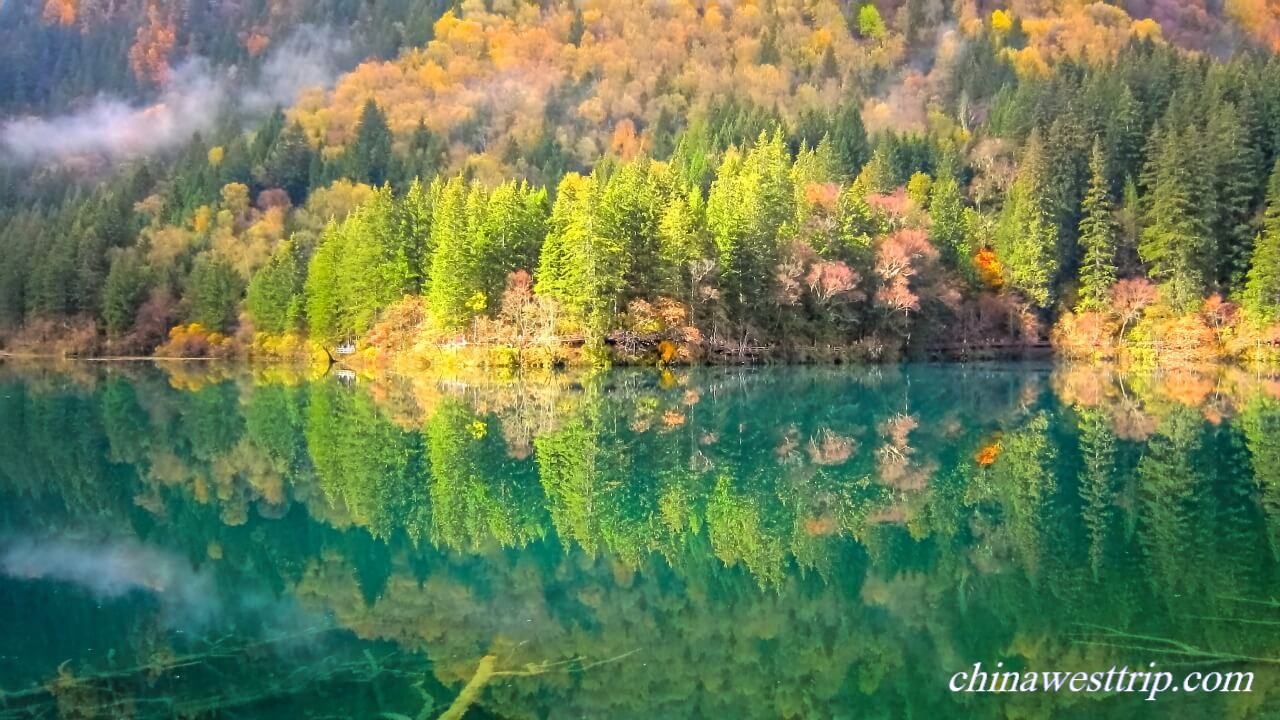
The Pearl Shallow Streem and the Pearl Waterfall
The Pearl Shallow Stream is 2,433 meters(7,982 feet) above the sea level, 160 meters(525 feet) in width and 200 meters(656 feet) in length. Thick bushes grow in clusters scattering in the water. The water runs rapidly on a slope that appears quite uneven due to the calcification. As the water unrolls, it splashes numerous tiny drops looking like pearls. The water rushes to the edge of the cliff and creates a magnificent waterfall. The Pearl Waterfall is in a 40-meter(131-foot) drop and 200 meters(656 feet) in width.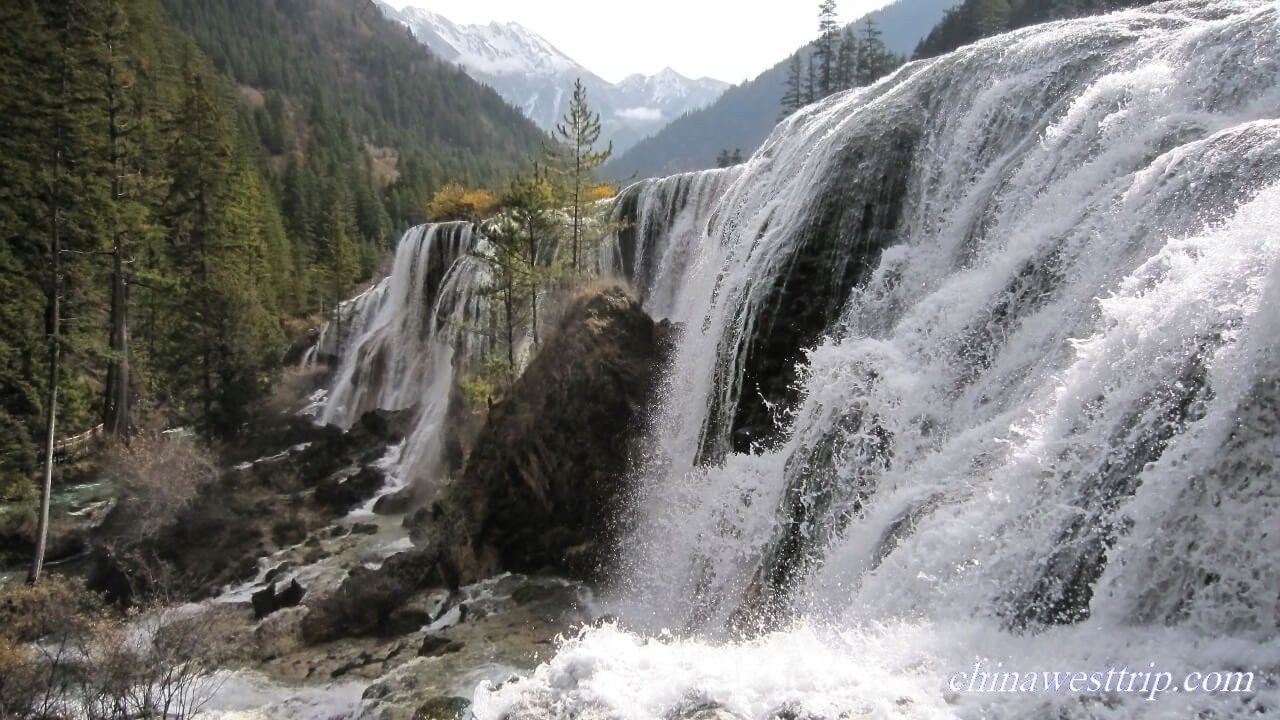
The Long Lake
The Long Lake is the largest and deepest in Jiuzhai Valley. It is located on the top of Zezhawa Valley where is 3,100 meters(10171 feet) above sea level. The lake is 7.5 km(4.66 miles) in length and 103 meters(338 feet) in depth at its deepest point. The natural beauty of the lake strikes visitors as a gorgeous landscape painting. The long lake remains unruffled, clouds float by, and water birds sport on the lake, the colorful forest casts its reflection in the water. It is a lake which would have existed only in the fairy land.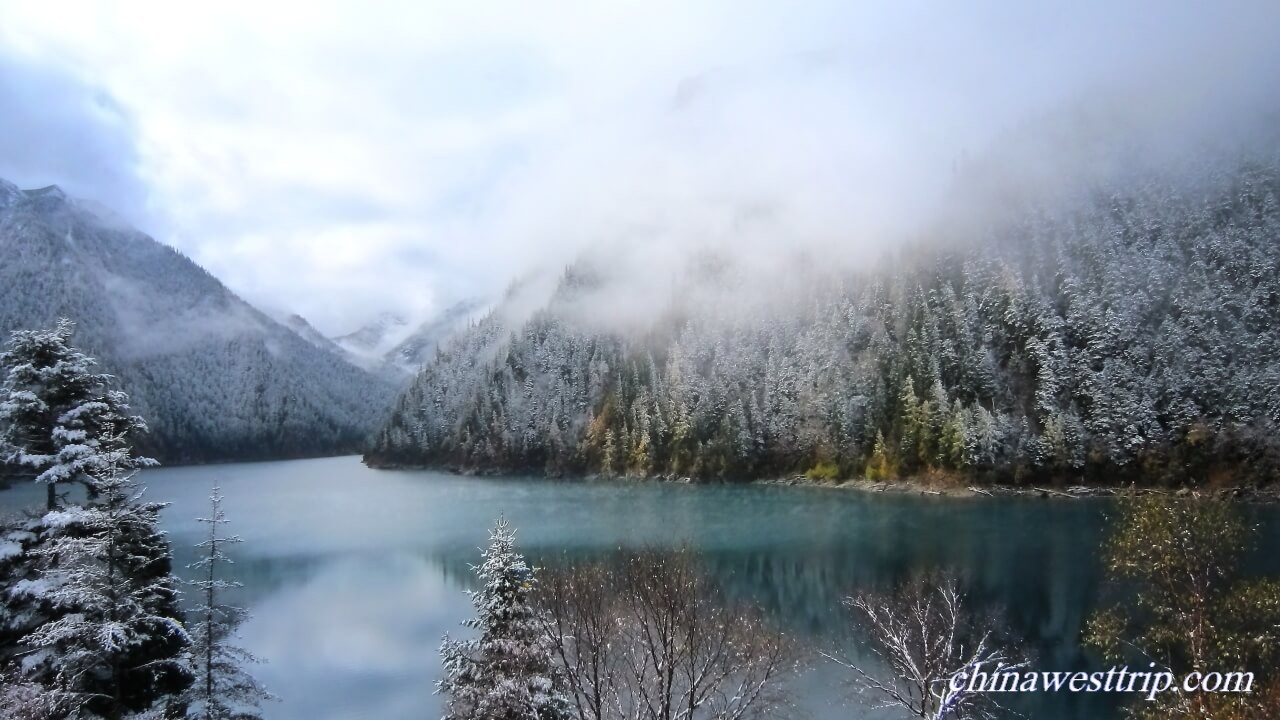
The Multicolored Pool
The Multicolored Lake is the smallest one in Jiuzhai Valley. It is 2,995 meters(9,826 feet) above sea level, 100.8 meter(331 feet) in length and 56 meter(184 feet) in width. Due to the ray scattering effect, the water in the pond appears translucent and multicolored. The colors are azure, light green, bright yellow and milky white. The pool has rich sponges, algae and ferns. In addition, bushes and reeds grow in the pool. As the sun casts lights on the water, the calcium sediments act on, scattering the rays on the clusters of water plants and refracting the light in multi-colors. It is commonly believed that the pool produces more colors than any other lakes and pools in the Valley.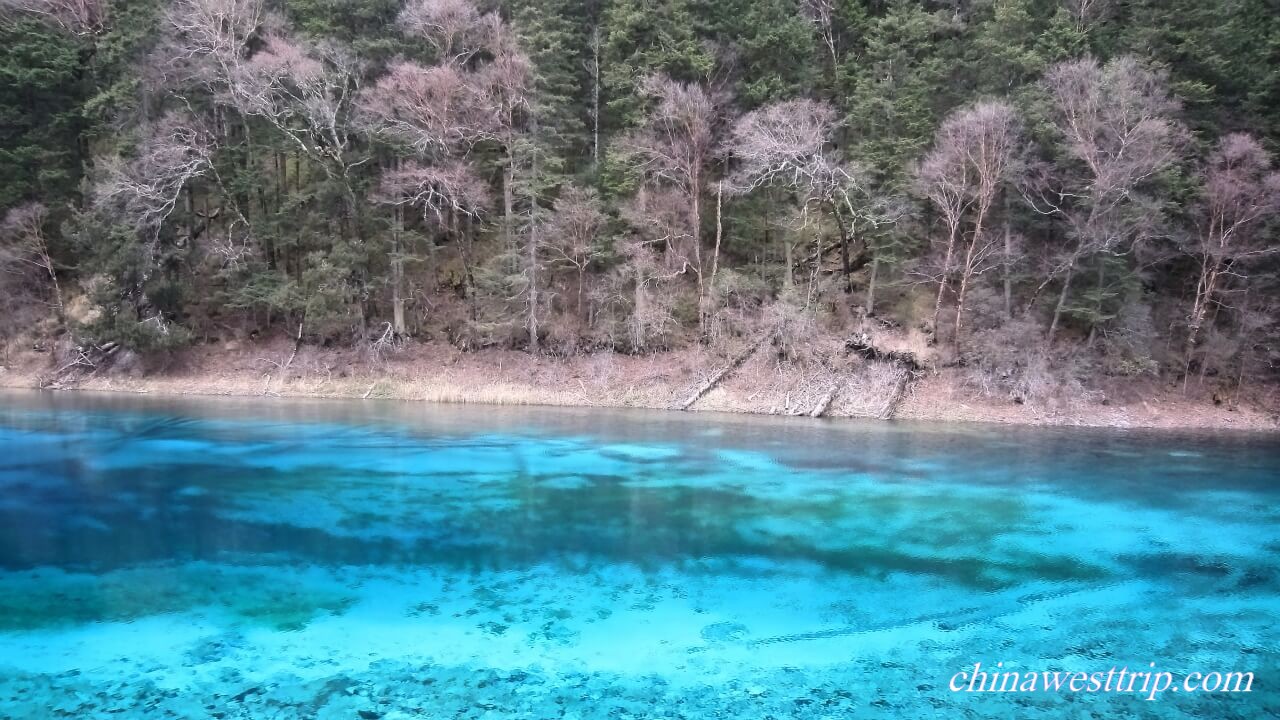
Shuzheng Waterfall
Shuzheng Waterfall is one of the main sightseeing spots in Jiuzhai Valley. It is 2,295 meters(7,530 feet) above sea level, 11 meters(36 feet) in height and 62 meters(203 feet) in width. A stream flows in the dense bushes. When it reaches the edge of the cliff, the water drops downwards creating a splendid waterfall.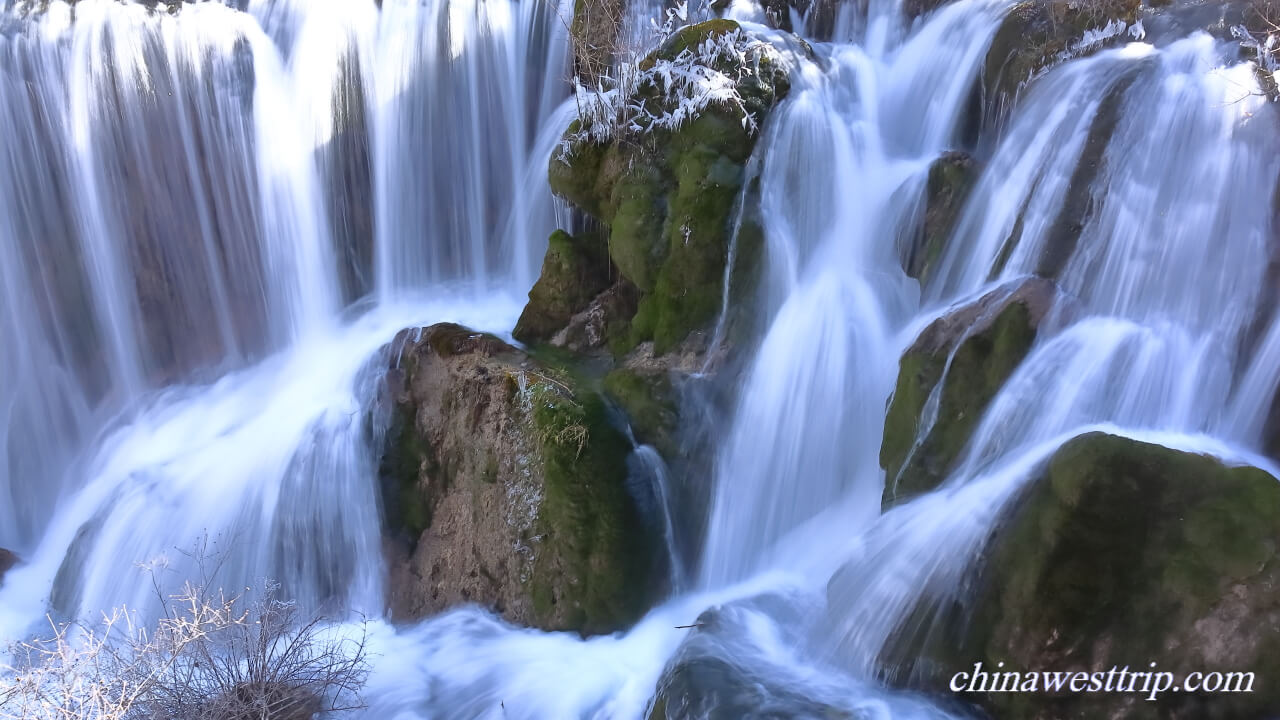
Shuzheng Village
Shuzheng Village is the largest one among the Tibetan villages in the valley. There are around 1,000 Tibetans living in the Valley. Shuzheng Village is inhabited by over 400 Tibetans.
Shuzheng Lakes
There are 19 small pools scattered in the thick bushes. Named after the nearby Shuzheng Village, the pools look like sapphires inlaid on the colorful forest.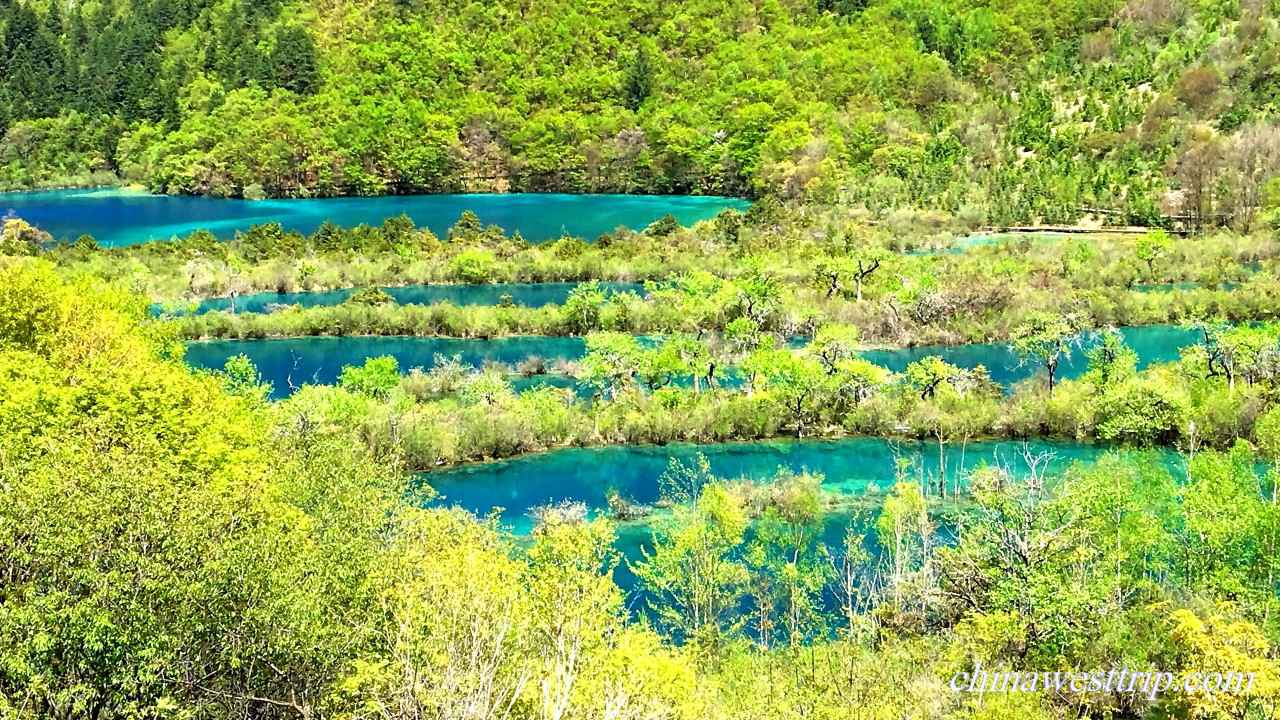
The Mirror Lake
The Mirror Lake covers an area of 19 hectares(47 acres). It is 2,390 meters(7,743 feet) above sea level, and 11 meters(36 feet) in depth at its deepest part. It is the most wonderful place for photographers to get a view of reflection.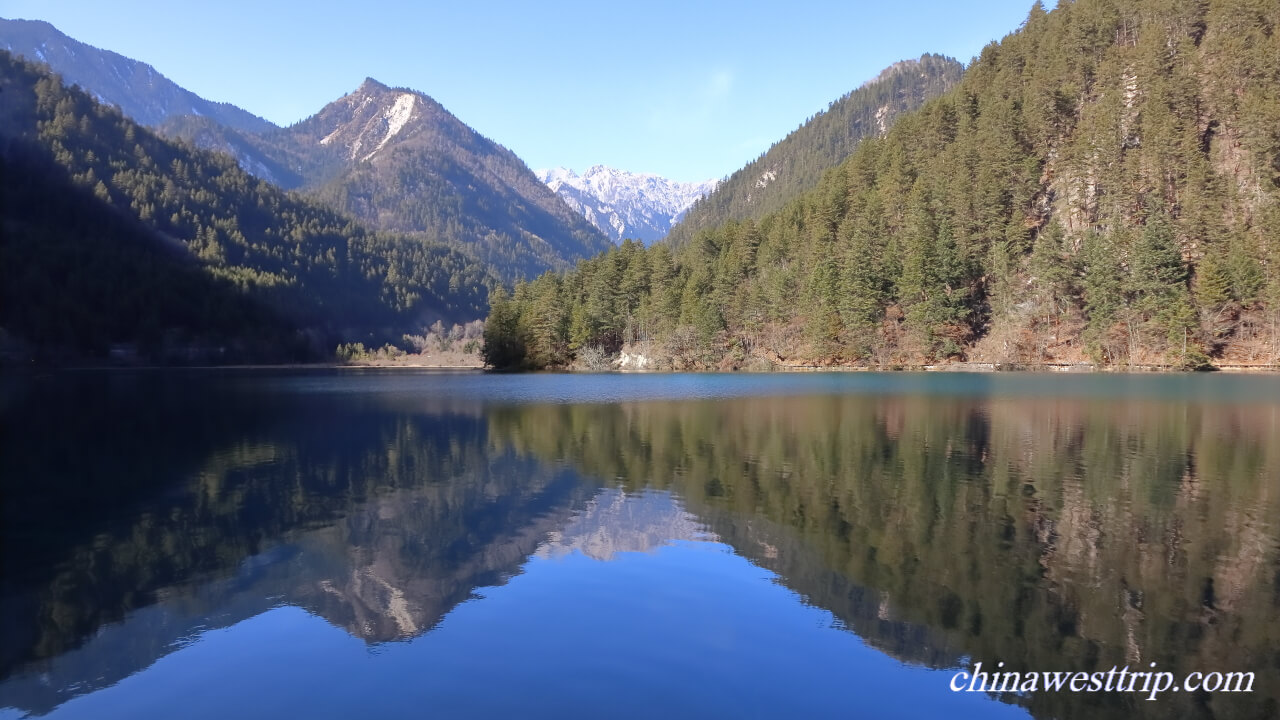
The Rhinoceros Lake
The Rhinoceros Lake is the second largest one in Jiuzhai Valley. It covers an area of 37 hectares(92 acres), and 18 meters(59 feet) in depth. A story goes that a long time ago, a Lama came here riding his rhinoceros. Before he arrived at the lake, he got sick. He was recovered after drinking the water in the lake. In order to safeguard the lake, he left his rhinoceros at the lake. It is said that sometimes people can see the image of the rhinoceros on the bottom of the lake. The lake is also a wonderful place for photographers to get a view of reflection.
The Tiger Lake
The lake is named as Tiger Lake due to its color. In the autumn, the colorful forest casts its reflection onto the surface of the water. It looks like tiger’s fur.
Travel Tips:
How to Get to Jiuzhaigou Valley
Jiuzhaihou Valley is located in the north of Sichuan Province. The town near the scenic area is called Zhangzha Town, 414 km(257 miles) away from Chengdu. Visitors usually drive to Jiuzhai Valley. It takes around 8 hours to get to the town by a car. About 82 km(51 miles) away from the town, there is an airport, Jiuzhai-Huanglong Airport. It operates the flights connecting Jiuzhaigou with Chengdu and cities in neighboring provinces, like Xian and Chongqing. But the altitude is quite high. It is 3459 meters(11350 feet) above sea level. We highly suggest our clients to travel to Jiuzhaigou by car, because most of people may suffer from altitude sickness if they directly ascend to the height over 3,000 meters(9,842 feet) above sea level. It takes time for the body to acclimate the high altitude. Read more about the Altitude Sickness.
How to Visit Jiuzhai Valley
The valley is quite huge. The sightseeing spots scatter in the three valleys. Sightseeing shuttle buses are operated by Jiazhaigou Administrative Office. An eight-hour tour is enough for the must-go sightseeing spots listed above. The route is arranged by the staffs at random based on the real-time flow of visitors. The shuttle bus usually goes directly to the top of Rize Valley or Zezhawa Valley. Visitors can walk around the lakes, then take other buses down to the next stops. Some people also do trekking along the paths in the valley. The paths are well-paved.
Suggested Tour Routes:
Route One: In the morning, take a shuttle to Rize Valley, stop at the Five-flower Lake. After walking around the lake, take another bus to the Pearl Shoal. Then step down stairs to visit the Pear Shoal Waterfall. Afterwards, walk to the Mirror Lake Bus Station, and have lunch at Nuorilang Visitor’s Service Center. On the way to the lunch place, visitors may make stop at the Mirror Lake. After lunch, ride the bus to Zezhawa Valley, stop at the Long Lake, then walk to the Multi-colored Pond, and go to Shuzheng Valley by bus. Visit the Rhinoceros Lake, Shuzheng Waterfall, Shuzheng Village, and Shuzheng Lakes one by one.
Route Two: In the morning, go to visit the Long Lake and the Multicolored Lake in Zezhawa Valley. After lunch, ride the shuttle to visit the sightseeing spots in Rize Valley, like the Five-flower Lake, the Pear Shoal, the Pear Shoal Waterfall, and the Mirror Lake. Then, take the bus to Shuzheng Valley to visit the Rhinoceros Lake, Shuzheng Waterfall, Shuzheng Village, and Shuzheng Lakes one by one.
How to Avoid Altitude Sickness
The altitude of Jiuzhai Valley ranges from 2,000 meters(6,561 feet) to 4,500 meters(14,763 feet) above sea level. The highest sightseeing spot visitors can reach is 3,101 meters(10,173 feet) above sea level. Even it is not that high, but visitor should try to avoid the AMS. Please read more about AMS.
Weather
The temperature in Jiuzhaigou Valley ranges from minus 2℃(28.4°F) to 12℃(53.6°F) in spring, 13℃(55.4°F) to 24℃(75.2°F) in summer, 18℃(64.4°F) to 27℃(80.6°F) in autumn and minus 1℃(30.2°F) to 15℃(59°F) in winter. The best time to visit Jiuzhaigou Valley is between September and October. Visitors should try to avoid going to Jiuzhaigou Valley in the rainy season. The rainy season in Sichuan lasts from July to August. Because the altitude is high, visitors should prepare warm coat and try to decrease the risk of catching a cold, even in the summer.
Lunch
Nuorilang Visitor’s Service Centre is located at the junction of the three valleys. It contains restaurants which offer visitors different types of meals, from buffet to Chinese table dishes.
Photography Tips
The top one place for photography is the Five-flower Lake. A tripod, a filter, telephoto lenses and wide angle lenses are needed. Both the Mirror lake and the Rhinoceros Lake are the most ideal places for a view of reflection. The best time to get to the lake is before 9 a.m., because there is usually no ripples on the surface of the water in the morning and in the late afternoon.
Recommended Tour:
Four-Days Fairyland Jiuzhai Valley with Panda Tour
Related Articles:
Huanglong National Park
Altitude Sickness
Author: Tina Luo
Update:

the Flaming Lake Jiuzhaigou
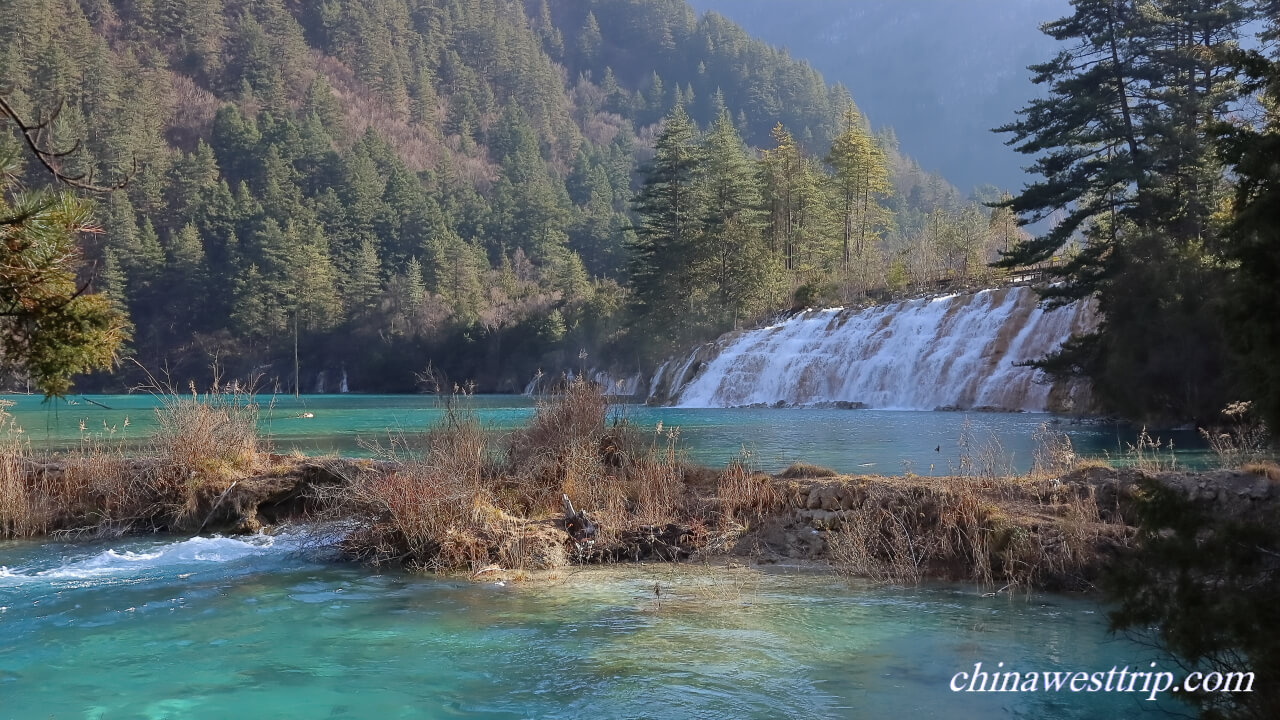
the Twin-Dragon Lake Jiuzhaigou
the Five-flower Lake Jiuzhaigou
Jiuzhaigou Valley
Jiuzhai Valley
Nuorilang Waterfall Jiuzhaigou
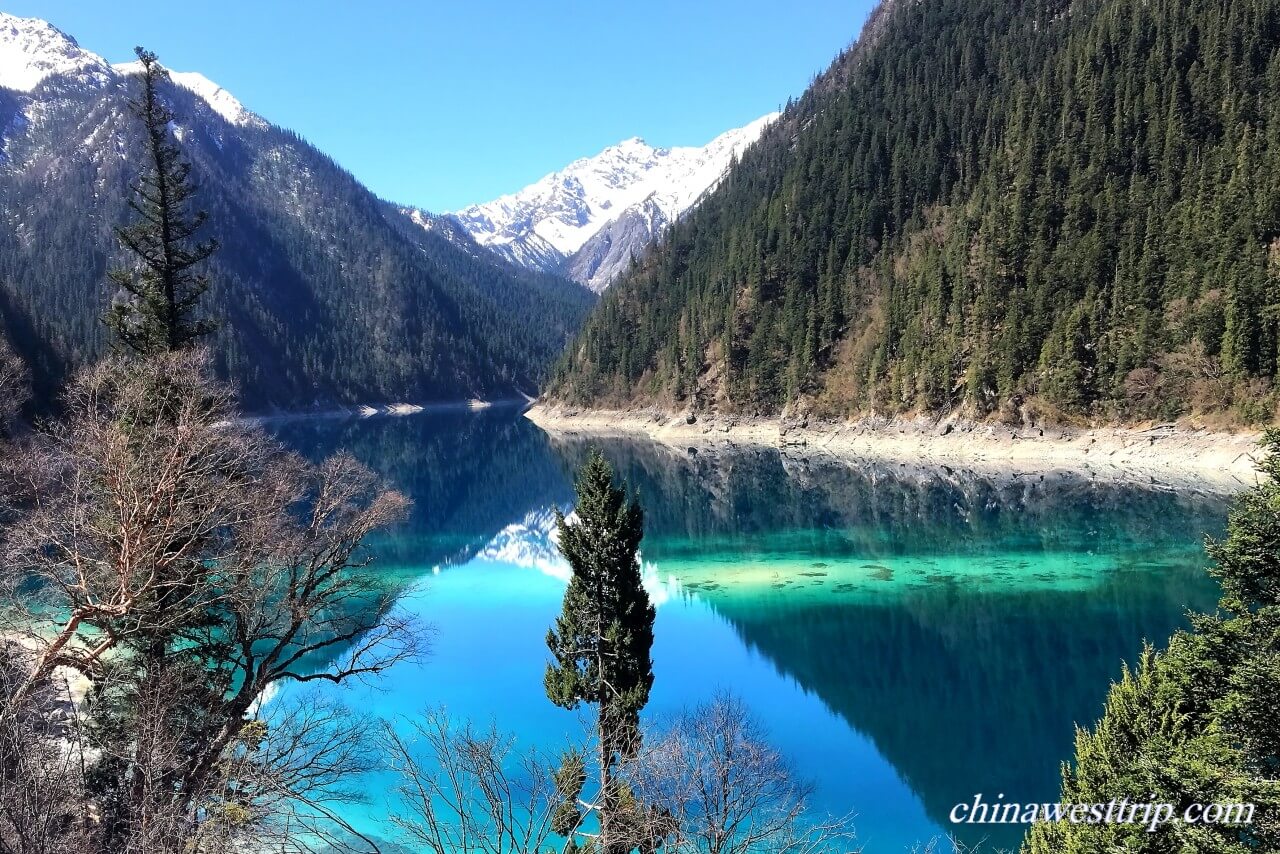
the Long Lake Jiuzhaigou